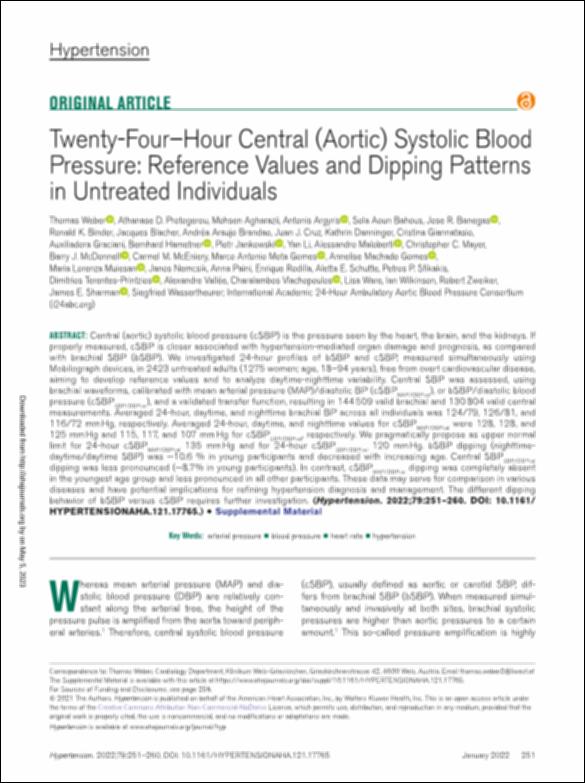Please use this identifier to cite or link to this item:
http://hdl.handle.net/10637/14242Twenty-four-hour central (Aortic) systolic blood pressure reference values and dipping patterns in untreated individuals
| Title: | Twenty-four-hour central (Aortic) systolic blood pressure reference values and dipping patterns in untreated individuals |
| Authors : | Weber, Thomas Protogerou, Athanase D. Agharazii, Mohsen Argyris, Antonis Bahous, Sola Aoun Banegas, Jose R. Rodilla Sala, Enrique |
| Keywords: | Blood pressure.; Presión sanguínea.; Pulse.; Hypertension.; Ritmo cardíaco.; Hipertensión. |
| Publisher: | Lippincott Williams & Wilkins. |
| Citation: | Weber, T., Protogerou, A. D., Agharazii, M., Argyris, A., Aoun Bahous, S., Banegas, J. R. et al. (2022). Twenty-four-hour central (Aortic) systolic blood pressure: reference values and dipping patterns in untreated individuals. Hypertension (Dallas, Tex. : 1979), vol. 79, i. 1 (jan.), pp. 251–260. DOI: https://doi.org/10.1161/HYPERTENSIONAHA.121.17765 |
| Abstract: | Central (aortic) systolic blood pressure (cSBP) is the pressure seen by the heart, the brain, and the kidneys. If properly measured, cSBP is closer associated with hypertension-mediated organ damage and prognosis, as compared with brachial SBP (bSBP). We investigated 24-hour profiles of bSBP and cSBP, measured simultaneously using Mobilograph devices, in 2423 untreated adults (1275 women; age, 18–94 years), free from overt cardiovascular disease, aiming to develop reference values and to analyze daytime-nighttime variability. Central SBP was assessed, using brachial waveforms, calibrated with mean arterial pressure (MAP)/diastolic BP (cSBPMAP/DBPcal), or bSBP/diastolic blood pressure (cSBPSBP/DBPcal), and a validated transfer function, resulting in 144 509 valid brachial and 130 804 valid central measurements. Averaged 24-hour, daytime, and nighttime brachial BP across all individuals was 124/79, 126/81, and 116/72 mm Hg, respectively. Averaged 24-hour, daytime, and nighttime values for cSBPMAP/DBPcal were 128, 128, and 125 mm Hg and 115, 117, and 107 mm Hg for cSBPSBP/DBPcal, respectively. We pragmatically propose as upper normal limit for 24-hour cSBPMAP/DBPcal 135 mm Hg and for 24-hour cSBPSBP/DBPcal 120 mm Hg. bSBP dipping (nighttimedaytime/ daytime SBP) was −10.6 % in young participants and decreased with increasing age. Central SBPSBP/DBPcal dipping was less pronounced (−8.7% in young participants). In contrast, cSBPMAP/DBPcal dipping was completely absent in the youngest age group and less pronounced in all other participants. These data may serve for comparison in various diseases and have potential implications for refining hypertension diagnosis and management. The different dipping behavior of bSBP versus cSBP requires further investigation. |
| Description: | Este artículo se encuentra disponible en la siguiente URL: https://www.ahajournals.org/doi/epdf/10.1161/HYPERTENSIONAHA.121.17765 |
| URI: | http://hdl.handle.net/10637/14242 |
| Rights : | http://creativecommons.org/licenses/by-nc-nd/4.0/deed.es |
| ISSN: | 0194-911X. 1524-4563 (Electrónico) |
| Language: | es |
| Issue Date: | 9-Jan-2022 |
| Center : | Universidad Cardenal Herrera-CEU |
| Appears in Collections: | Dpto. Medicina y Cirugía |
Items in DSpace are protected by copyright, with all rights reserved, unless otherwise indicated.


